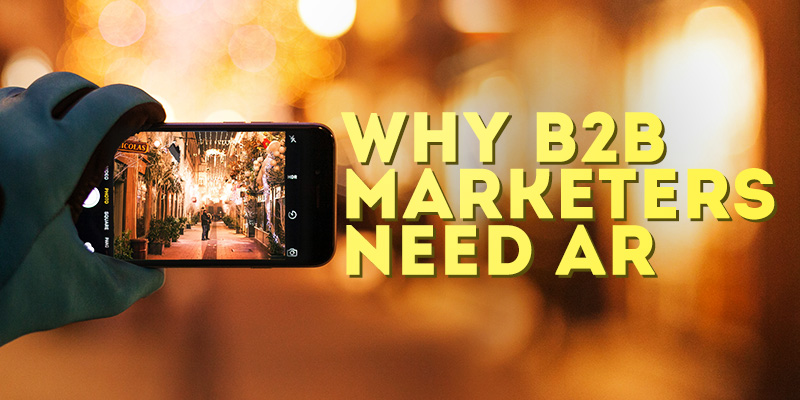The definition of business-to-business (B2B) is rapidly changing. While B2B used to refer to commercial transactions between businesses, the power of augmented reality (AR) is transforming B2B by changing how businesses interact with one another. B2B is becoming more than business-to-business marketing; even more than B2B sales. AR is expanding businesses’ ability to connect with each other across multiple channels, and it is increasing the reasons they do so.
In this article, we will examine how augmented reality can help businesses promote their products and services to other enterprises. More exciting for some, we will also explore new ways businesses can use AR to connect with corporate customers, vendors, and partners.
Augmented Reality in B2B Marketing
When compared with advertising to consumers, B2B advertisers face smaller, tighter markets, which means they also face stiffer competition. There is no room for taking high-stakes gambles when marketing to other companies. Marketing campaigns must be more focused and their messages more targeted than most consumer marketing efforts. For this reason, B2B marketers must ensure that adoption of augmented reality technology for marketing follows a well-designed strategy, especially email marketing campaigns.
This does not mean that AR finds its Achilles heel in marketing. On the contrary; the visual power of augmented reality lends itself perfectly to B2B marketing. Carefully-orchestrated marketing plans, coupled with professionally-designed and customized AR apps, can increase your company’s brand awareness like nothing else can.
Here’s a couple of ways AR technology can supercharge your B2B marketing efforts.
Sales & Demos
Fortunately for salespersons who hit the street every day, visiting prospective corporate clients, AR does not eliminate the need for one-on-one sales efforts. In fact, it makes their sales efforts more effective.
Gone are the days when a salesman or saleswoman presents prospects with a slick flyer, or even a PowerPoint presentation. The salesperson armed with a mobile device, loaded with custom AR software, has a distinctive edge over those who are not. Through the power of AR, salespersons can capture their prospects by bringing virtual products right into the meeting room.
Using AR apps, a carpet company can show an office manager what various carpet designs would look like installed in their office. A manufacturing engineer can see how a new production line would fit on the production floor. A physician can see how a powerful AR medical applications can help her better diagnose her patients. And an architect can show a client how a new room addition will look from the outside when completed.
The ways in which on-site 3D, interactive AR product models can be used to demo and sell products are limitless. Companies who tap the power of AR early will not only pave the way for those who follow, but they will pave the way for their own future growth.
Trade Shows
Trade shows are all about getting attention. Regardless of the product or service you are pitching, your goal as a vendor is to make people go “wow.” A stack of flyers won’t do that. A video running in a loop probably won’t do that. A mobile device feeding video of a 3D interactive AR product model to a large flat screen will not only wow the crowd, it will make them focus on your product with a fascination other mediums can’t inspire. And fascination is good for sales.
The day will come when AR presentations at trade shows is the norm. For now, it’s how you stand out from the crowd.
AR Tools of the Trade
Don’t think AR’s only B2B value is marketing. B2B sales is only one way in which businesses and industries interact. Augmented reality technology can also provide the tools that one company uses to serve another.
For example, AR apps can help the carpenter plan a construction project by superimposing images of the final design over a camera image of the client’s environment — built-in measurement features can help with the project layout. A service contractor can use AR apps to superimpose technical data over an image of an air conditioning unit he is servicing. Or, a warehousing company can view client’s inventory information by viewing storage racks using their AR-enabled smartphone or pad.
Though hardly scratching the surface, these examples reveal the power of AR technology in helping companies serve companies better.
Businesses realizing the potential of AR apps want custom yet affordable jobs done. Countless factors affect and alter the augmented reality application cost.
Augmented Reality B2B Product Support
Companies not only buy products from other companies; they also need customer service for many of the products they purchase. From poorly-written user manuals to poorly-written online self-help portals, product support hasn’t changed very much. But augmented reality is changing all that.
By layering how-to information over a product image as viewed on a mobile device or AR viewer, augmented reality can display interactive text and images that instruct the user how to setup, configure, troubleshoot and repair a wide variety of products.
AR-based customer support has barely broken ground in the consumer market, but opportunities are also great for developers who can target B2B industries with AR solutions.
B2B Collaboration
Digital collaboration opens a world of opportunity for augmented reality application in the B2B market. By allowing the B2B audience to view interactive 3D models on their smartphones and tablets, companies can go beyond the limitations of video conferencing and engage participants on a whole new level.
AR-based remote collaboration is ideally suited for product design, project planning, and product maintenance where multiple companies need to come together to reach a solution.
AR Apps for B2B
An increasing number of companies are turning to AR technology to better serve consumers. This creates a new and potentially explosive market for augmented reality app and software developers. For every company that wants to engage their customers using AR, there must be an AR app developer to make it happen.
While some companies have in-house development teams, most do not. The need for 3rd-party AR B2B app development is likely to grow rapidly as more and more companies like Lowe’s Home Improvement and Ikea make AR apps commonplace.
Unlike virtual reality, AR only requires the use of a mobile device. While AR viewers can be used, they are seldom required. The readily-available hardware and increasing adoption will drive the B2B augmented reality app market. The only question is, will there be enough AR app developers to meet the demand for B2B AR applications?
The Bottom Line
Forward-thinking developers would do well to seize the unique opportunity presented by the AR B2B market. Whether one aims to provide AR solutions that bridge industries and companies, or to provide AR products other companies can use to serve their customers, now is the time to move. Tomorrow, the ice will have already been broken.

 (4 votes, average: 4.50 out of 5)
(4 votes, average: 4.50 out of 5)
